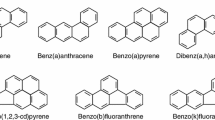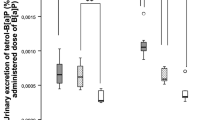Abstract
Six groups of C57BL/6J mice received single oral doses of 1.5–10.6 nmol/kg 1,2,3,7,8-pentachlorodibenzo-p-dioxin (PnCDD), 1,2,3,6,7,8-hexachlorodibenzo-p-dioxin (HxCDD) or 2,3,4,7,8-pentachlorodibenzofuran (PnCDF) as single compounds or in combination with 300 μmol/kg 2,2′,4,4′,5,5′-hexachlorobiphenyl (HxCB). Two other groups of mice received a mixture of the first three compounds, either with or without HxCB. The hepatic deposition and elimination of the compounds and their CYP1a dependent 7-ethoxyresorufin-O-deethylation (EROD) activity were studied until day 175. Interactive effects on the hepatic deposition of PnCDD were observed in most of the mixed dose groups. For HxCDD and PnCDF interactive effects were either very small or absent. No interactive effects were observed on hepatic elimination rates of PnCDD, HxCDD or PnCDF. No evidence was found for the influence of HxCB cotreatment on the hepatic concentration-response curves of the three compounds or their mixture. Based on the results from the present study it is concluded that PCDDs, PCDFs and PCBs may influence each other's, toxicokinetics when administered in mixtures.
Similar content being viewed by others
References
Abraham K, Krowke R, Neubert D (1988) Pharmacokinetics and biological activity of 2,3,7,8-tetra-chlorodibenzo-p-dioxin: 1. Dose-dependent tissue distribution and induction of hepatic ethoxyresorufin-O-deethylase in rats following a single injection. Arch Toxicol 62: 359–368
Bannister R, Safe S (1987) Synergistic interactions of 2,3,7,8-TCDD and 2,2′,4,4′,5,5′-hexachlorobiphenyl in C57BL/6J and DBA/2J Mice: role of the Ah receptor. Toxicology 44: 159–169
Biegel L, Harris M, Davis D, Rosengren R, Safe L, Safe S (1989) 2,2′,4,4′,5,5′-Hexachlorobiphenyl as a 2,3,7,8-tetrachlorodibenzo-p-dioxin antagonist in C57BL/6J mice. Toxicol Appl Pharmacol 97: 561–571
Brewster D, Birnbaum L (1987) Disposition and excretion of 2,3,4,7,8-pentachlorodibenzofuran in the rat. Toxicol Appl Pharmacol 90: 243–252
Buckley-Kedderis L, Diliberto J, Linko P, Goldstein J, Birnbaum L (1991) Disposition of 2,3,7,8-tetrabromodibenzo-p-dioxin in the rat: biliary excretion and induction of cytochromes CYP1A1 and CYP1A2. Toxicol Appl Pharmacol 111: 163–172
Curtis LR, Kerkvliet NI, Baecher-Steppan L, Carpenter HM (1990) 2,3,7,8-Tetrachlorodibenzo-p-dioxin pretreatment of female mice altered tissue distribution but not hepatic metabolism of a subsequent dose. Fundam Appl Toxicol 14: 523–531
Davis D, Safe S (1990) Immunosuppressive activities of polychlorinated biphenyls in C57BL/6N mice: structure-activity relationships as Ah receptor agonists and partial antagonists. Toxicology 63: 97–111
De Jongh J, Wondergem F, Seinen W, Van den Berg M (1992) Absence of interactions on hepatic retention and 7-ethoxyresorufin-O-deethylation activity after co-administration of 1,2,3,7,8-pentachlorodibenzo-p-dioxin and 2,4,5,2′,4′,5′-hexachlorobiphenyl. Toxicology 75: 21–28
De Jongh J, Wondergem F, Seinen W, Van den Berg M (1993) Toxicokinetic interactions between chlorinated aromatic hydrocarbons in the liver of the C57BL/6J mouse: 1. polychlorinated biphenyls (PCBs). Arch Toxicol (in press)
Denomme MA, Leece B, Li A, Towner R, Safe S (1986) Elevation of 2,3,7,8-tetrachlorodibenzo-p-dioxin (TCDD) rat hepatic receptor by polychlorinated biphenyls. Structure-activity relationships. Biochem Pharmacol 35: 277–282
Dewailly E, Weber JP, Gingras S, Laliberté C (1991) Coplanar PCBs in human milk in the province of Québec, Canada: are they more toxic than dioxin for breast fed infants? Bull Environ Contam Toxicol 47: 491–498
Hori S, Kashimoto T, Kunita N (1982) Effects of polychlorinated dibenzofuran on the retention of polychlorinated biphenyl isomers in the liver and adipose tissue of mice. J Food Hyg Soc Japan 23: 167–175
Jensen AS (1987) Polychlorinated biphenyls (PCBs), polychlorinated dibenzo-p-dioxins (PCDDs) and polychlorinated dibenzofurans (PCDFs) in human milk, blood and adipose tissue. Sci Total Environ 64: 259–293
Kamimura H, Koga N, Oguri K, Yoshimura H, Honda Y, Nakano M (1988) Enhanced faecal excretion of 2,3,4,7,8-pentachlorodibenzofuran in rats by a long-term treatment with activated charcoal beads. Xenobiotica 18: 585–592
Kuroki J, Koga N, Yoshimura H (1986) High affinity of 2,3,4,7,8-pentachlorodibenzofuran to cytochrome P-450 in the hepatic microsomes of rats. Chemosphere 15: 731–738
Leece B, Denome MA, Towner R, Li A, Landers J, Safe S (1987) Nonadditive interactive effects of polychlorinated biphenyl congeners in rats: role of the 2,3,7,8-tetrachlorodibenzo-p-dioxin receptor. Can J Physiol Pharmacol 65: 1908–1912
Leung H, Ku R, Paustenbach D, Andersen M (1988) A physiologically based pharmacokinetic model for 2,3,7,8-tetrachlorodibenzo-p-dioxin in C57BL/6J and DBA/2J mice. Toxicol Lett 42: 15–28
Leung H, Paustenbach D, Murray F, Andersen M (1990) A physiological pharmacokinetic description of the tissue distribution and enzyme-inducing properties of 2,3,7,8-tetrachlorodibenzo-p-dioxin in the rat. Toxicol Appl Pharmacol 103: 399–410
Lowry OH, Rosebrough NJ, Farr AL, Randall RJ (1951) Protein measurement with folin phenol reagent. J Biol Chem 193: 265–275
Mckinley MK, Diliberto JJ, Birnbaum LS (1991) 2,3,7,8-Tetrachlorodibenzofuran (TCDF) pretreatment alters the hepatic metabolism of a subsequent dose. In: Dideriksen R, Hart B, Wills S (eds) Abstracts of the 11th International Symposium on Chlorinated Dioxins and Related Compounds UNC, Chapel Hill, p 144
Morrissey R, Harris M, Diliberto J, Birnbaum L (1992) Limited PCB antagonism of TCDD-induced malformations in mice. Toxicol Lett 60: 19–25
Niimi AJ, Olivier BG (1989) Assessment of relative toxicity of chlorinated dibenzo-p-dioxins, dibenzofuerans, and biphenyls in Lake Ontario salmonids to mammalian systems using toxic equivalent factors (TEF). Chemosphere 18: 1413–1423
Parkinson A, Safe S, Robertson LW, Thomas PE, Ryan DE, Reik LM, Levin W (1983) Immunochemical quantitation of cytochrome P-450 isoenzymes and epoxide hydrolase in liver microsomes from polychlorinated or polybrominated biphenyl-treated rats. J Biol Chem 258: 5967–5976
Poland A, Teitelbaum P, Glover E (1989) [125I]2-Iodo-3,7,8-trichlorodibenzo-p-dioxin-binding species in mouse liver induced by agonists for the Ah receptor: characterization and identification. Mol Pharmacol 36: 113–120
Rappe C, Andersson R, Bergqvist PA, Brohede C, Hansson M, Kjeller LO, Lindström G, Marklund S, Nygren M, Swanson SE, Tysklind M, Wiberg K (1987) Overview on environmental fate of chlorinated dioxins and dibenzofurans. Sources, levels and isomeric pattern in various matrices. Chemosphere 16: 1603–1618
Rutten AAJJL, Falke HE, Catsburg JF, Topp R, Blaauboer BJ, van Holsteijn I, Doorn L, van Leeuwen FXR (1987) Interlaboratory comparison of total cytochrome P-450 and protein determinations in rat liver microsomes. Arch Toxicol 61: 27–33
Ryan JJ, Lizotte R, Lau BPY (1985) Chlorinated dibenzo-p-dioxins and chlorinated dibenzofurans in Canadian human adipose tissue. Chemosphere 14: 697–706
Safe S (1990) Polychlorinated biphenyls (PCBs), dibenzo-p-dioxins (PCDDs), dibenzofurans (PCDFs), and related compounds: mechanistic considerations which support the development of toxic equivalency factors (TEFs). Crit Rev Toxicol 21: 51–88
Safe S (1991) Polychlorinated dibenzo-p-dioxins and related compounds: sources, environmental distribution and risk assessment. Environ Carcino Ecotox Rev 9: 261 -302
Tanabe S, Kannan N, Subramanian A, Wantanabe S, Tatsukawa R (1987) Highly toxic coplanar PCBs: occurrence, source, persistency and toxic implications to wildlife and humans. Environ Pollut 47: 147–163
Tsyrlov I. Duzchak T (1990) Interspecies features of hepatic cytochromes P450IA1 an P450IA2 in rodents. Xenobiotica 20: 1163–1170
Van den Berg M, Van Wijnen J, Wever H, Seinen W (1989 a) Selective retention of toxic polychlorinated dibenzo-p-dioxins and dibenzofurans in the liver of the rat after intravenous administration of a mixture. Toxicology 55: 173–182
Van den Berg M, De Jongh J, Eckhart P, Van der Wielen F (1989 b) Disposition and elimination of three polychlorinated dibenzofurans in the liver of the rat. Fundam Appl Toxicol 12: 738–747
Van den Berg M, Bouwman C, Seinen W (1989c) Hepatic retention of PCDDs and PCDFs in C57Bl/6 and DBA/2 mice. Chemosphere 19: 795–802
Voorman R, Aust S (1987) Specific binding of polyhalogenated aromatic hydrocarbon inducers of cytochrome P-450d to the cytochrome and inhibition of its estradiol 2-hydroxylase activity. Toxicol Appl Pharmacol 90: 69–78
Voorman R, Aust SD (1989) TCDD (2,3,7,8-tetrachlorodibenzo-p-dioxin) is a tight binding inhibitor of cytochrome P-450d. J Biochem Toxicol 4: 105–109
Wacker R, Poiger H, Schlatter C (1986) Pharmacokinetics and metabolism of 1,2,3,7,8-pentachlorodibenzo-p-dioxin in the rat. Chemosphere 15: 1473–1476
Yoshimura Y, Kamimura H, Oguri K, Honda Y, Nakano M (1986) Stimulating effect of activated charcoal beads on fecal excretion of 2,3,4,7,8-pentachlorodibenzofuran in rats. Chemosphere 15: 219–227
Author information
Authors and Affiliations
Rights and permissions
About this article
Cite this article
De Jongh, J., Nieboer, R., Schröders, I. et al. Toxicokinetic mixture interactions between chlorinated aromatic hydrocarbons in the liver of the C57BL/6J mouse: 2. polychlorinated dibenzo-p-dioxins (PCDDs), dibenzofurans (PCDFs) and biphenyls (PCBs). Arch Toxicol 67, 598–604 (1993). https://doi.org/10.1007/BF01974066
Received:
Accepted:
Issue Date:
DOI: https://doi.org/10.1007/BF01974066




